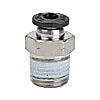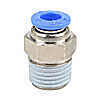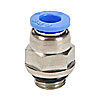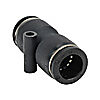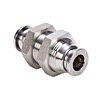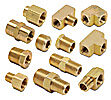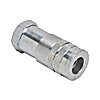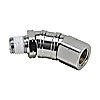 Cookies are not enabled on your browser.
Cookies are not enabled on your browser.Cookies are required for our site. Please enable cookies in your browser preferences to continue.
We will close at 3PM ET on Tuesday, December 23rd. Please note our shipping changes for Tuesday.
Freight shipments, FedEx ground and customer pickup deadline is 11:00AM ET. FedEx Priority (and free 2-day delivery) cutoff will be 1:00 PM ET. No UPS shipping will be available on Tuesday.
Drop ship vendors, Saginaw, Husky and Weigmann will also be closed Friday, Dec 26th.
Merry Christmas to each of you and your families from the employees of AutomationDirect
- Barcode / RFID / Vision
- Bulk Wire & Cable
- Cables (Terminated)
- Circuit Protection / Fuses / Disconnects
- Communications
- Drives & Soft Starters
- Enclosure Thermal Management & Lights
- Enclosures & Racks
- Field I/O
- HMI (Human Machine Interface)
- Hydraulic Components
- Motion Control
- Motor Controls
- Motors
- Pneumatic Components
- Power Products (Electrical)
- Power Transmission (Mechanical)
- Process Control & Measurement
- Programmable Controllers
- Pushbuttons / Switches / Indicators
- Relays / Timers
- Safety
- Sensors / Encoders
- Stacklights
- Structural Frames / Rails
- Tools & Test Equipment
- Valves
- Water (Potable) Components
- Wire & Cable Management
- Wire & Cable Termination
- Retired Products
Configuration Utilities
- PLC Family Selector
- P1000 PLC Systems
- P2000 PLC Systems
- P3000 PLC Systems
- ProductivityCODESYS
- CLICK PLC Systems
- Do-more® BRX PLC Systems
- LS-Electric® XGB PLC Systems
- Productivity®Open Systems
- Datalogic® Safety Light Curtains
- LS-Electric® Servo Systems
- Nitra® Pneumatic Grippers
- Object Detection (Sensors)
- PAL Controller Configurator
- Precision Gearbox Selector
- Protos X® Field I/O
- Pyrometers Selector
- Quadritalia® Modular Enclosures
- Stellar® Soft Starters
- Stepper System Selector
- SureFrame T-slot Extrusion
- SureMotion® XYZ Gantry
- SureServo2® System Selector
- SureStep® Linear Actuators
- Timing Belts & Pulleys
- Werma® Stacklights
- ZIPLinks
Fittings
Fittings
Fittings are used extensively to facilitate the connection of tubing and hose to the various components that make up all pneumatic systems. A wide variety of fittings are available to meet application criteria and personal preference:
Summary
Specifying and installing fittings and tubing sometimes feels like a puzzle, and you will likely find during the assembly process that you missed some fittings. It’s common to require multiple orders to get everything connected as desired. Due to their relatively low cost (and the fact that most fittings are sold in 'multi-packs'), it may be advantageous to purchase extra fittings with each order, and develop an inventory of fittings for use on future projects.

NITRA Fittings
Common Types of Fittings
Barb fittings

Barb fittings
Barb fittings are a simple way to connect flexible tubing or hose. The tubing is simply pushed over a barb that is slightly larger than the inside diameter (ID) of the tubing. A hose clamp is often added to secure the tubing more tightly. While easy to use, barb fittings have a higher risk of leaking or of the tubing popping off.
Compression fittings

Compression fittings
Compression fittings use a small barrel-shaped piece called a ferrule that slips over the outside diameter (OD) of the tube and is then compressed between a nut and the other half of the fitting. While creating a very secure connection, removing the tubing later can be difficult and often the tubing is deformed to the point that a new tube must be used to reconnect the fitting.
Push-to-connect fittings
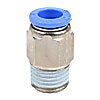
Push-to-connect fittings
With push-to-connect fittings, flexible tubing is easily connected by inserting the tubing end into the fitting. To release the tubing, the circular release ring is pressed and the tubing is pulled out. Due to their ease of use, and solid reliability, push-to-connect fittings have become one of the most popular fittings for machinery and automation assemblies.
Plastic/brass push-to-connect fittings typically use strong thermoplastic with stainless steel tube-gripping claws, and threaded components made of nickel-plated brass. These fittings provide an excellent solution for most applications. In harsher environments (high temperature and wash-down applications), more expensive all-metal push-to-connect stainless steel fittings are sometimes required.
Brass threaded fittings
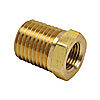
Brass threaded fittings
While they don't typically connect directly to tubing or hose, brass connectors, bushings, elbows, tees, and plugs are often required to adapt or convert between thread sizes, or for other miscellaneous connections to many pneumatic devices.
Quick-disconnect couplings

Quick-disconnect couplings
Quick-disconnect air couplings are great for situations where the air line needs to be connected and disconnected frequently. Swivel style QD fittings are particularly handy on hand tools, and allow maximum freedom of movement with the tool, and help prevent kinking of the attached hose.
Special Fittings
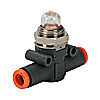
Special Purpose Pneumatic Fittings
Special Fittings
Getting tubing connected between valves and cylinders often requires more than just a simple male connector or elbow. Several special purpose push-to-connect fittings are available to improve integration and operation of pneumatic systems. For example, flow control valves are often used on cylinders to control their speed, and they frequently require these special fittings.
Other useful and convenient fittings include mini shutoff valves, mini gauges, check valves and quick exhaust valves. These devices should be considered to control machine pneumatic functionality and to monitor air usage.
Shop for NITRA® Fittings
Check out our job openings
Free Online PLC Training
FREE Video Tutorials
FREE e-Newsletter
Automation Notebook
Product Literature
White Papers
News, Product and Training Bulletins
E-Books
 Safe &
Secure
Safe &
Secure

We accept VISA, MasterCard, Discover, American Express, PayPal or company purchase orders.
Voted #1 mid-sized employer in Atlanta
Check out our
job openings

